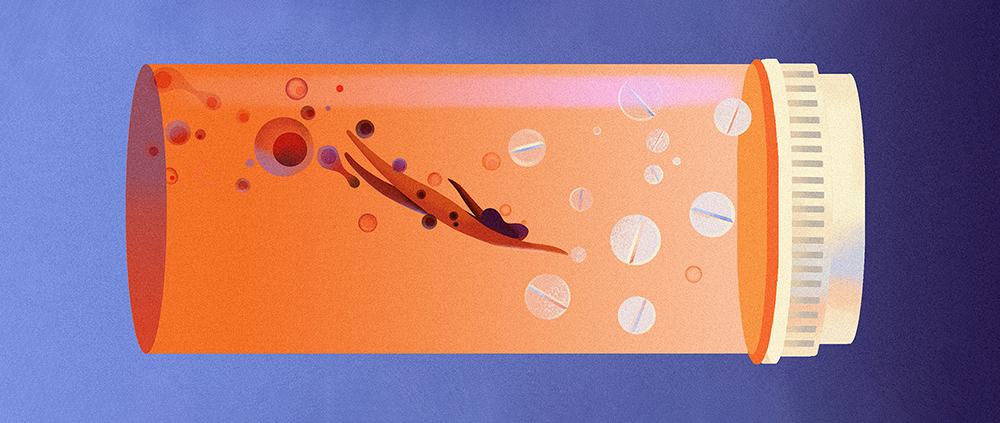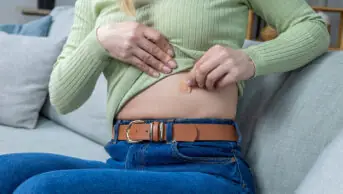“My symptoms began shortly after I reached puberty,” says Ashita, a 29-year-old applied behaviour analysis tutor. “I recall episodes of severe pain and heavy bleeding during my early teenage years.”
Over time, Ashita (who asked to keep her surname private) developed additional symptoms — “bloating, lower back pain, mood swings, anxiety” — all of which progressively affected her quality of life.
“Initially, my complaints were often addressed with painkillers,” she remembers. It wasn’t until Ashita became anaemic that her GP referred her for an ultrasound. That was when she was told she had endometriosis. The diagnosis was confirmed when Ashita had laparoscopic surgery.
In the UK, endometriosis affects an estimated one in ten women and those assigned female at birth, although its true prevalence is hard to ascertain, partly because the only way to obtain a definitive diagnosis is through surgery.
It is a condition in which tissue similar to the lining of the uterus grows outside of the womb. “That can appear anywhere in the body, even in places like the lung,” says Andrew Horne, director of the Centre for Reproductive Health at the University of Edinburgh.
But the most common site is the pelvis1, where endometriosis is typically categorised into three subtypes: ovarian, deep, and superficial peritoneal2. “Imaging will largely only detect ovarian and deep disease,” says Horne.
Long path to diagnosis
For Gabriella Pearson, an endometriosis sufferer and co-founder of the Menstrual Health Project, imaging did not offer answers. She started her period aged 10 years, and by the age of 12 years her mum took her to the doctors “because I was bleeding through my school skirt [and] in a lot of pain”.
Her symptoms evolved to include abdominal pain, erratic bowel movements, rectal bleeding, fatigue and nausea. “I went back and forth for about six or seven years being told that it was IBS, it was gluten intolerance, it was stress.” Eventually, her mother came across a small article about endometriosis in the paper. “She said, ‘I think you’ve got this’.”
Aged 22 years, her GP referred her for a transvaginal ultrasound. With nothing definitive on the scan, Pearson had to battle for a referral to a gynaecologist, who organised a laparoscopy. It took 11 years from her first doctor’s visit to finally get a diagnosis.
This kind of delay is not unusual. According to Faye Farthing, head of communications for Endometriosis UK, the charity’s latest research shows it currently takes on average “a shocking nearly nine years to get a diagnosis of endometriosis — and this hasn’t improved in over a decade”3.
A lot of women with similar symptoms may not necessarily have endometriosis
Lucky Saraswat, consultant gynaecologist at the Aberdeen Endometriosis Centre
In November 2024, the National Institute for Health and Care Excellence (NICE) updated its guidelines for endometriosis to address this, clarifying referral pathways and recommending earlier imaging4. Farthing is hopeful the changes “will have a positive impact on patient care” – but stresses that implementation by healthcare practitioners is crucial “if it is to have any impact”.
Horne says one hurdle that some patients must overcome is “lack of awareness and normalisation of pain”. Rhian Evans, an obstetrics and gynaecology pharmacist at Cardiff and Vale Health Board, ascribes this normalisation to “the inequality that is in women’s health and the ‘gender pain gap’”, where women’s pain is more likely to be dismissed, misdiagnosed or not treated by healthcare professionals compared with men.
Another challenge is that endometriosis can mimic several different conditions. “A lot of women with similar symptoms may not necessarily have endometriosis,” acknowledges Lucky Saraswat, a consultant gynaecologist at the Aberdeen Endometriosis Centre. Until a validated non-invasive diagnostic test becomes available, women will still have to go through surgery.
However, Horne believes we are getting close to a biomarker test with research underway. “There are a few commercial tests available on the market,” he says, but warns that there are not enough data to support them yet.
Contraceptive approach
Even with a diagnosis, “there’s no cure for endometriosis,” Saraswat points out.
In the meantime, most patients are treated empirically, usually with painkillers and hormonal contraceptives. The latter can be helpful because endometriosis “feeds on the oestrogen secreted by ovaries”, Saraswat explains.
“We would routinely start with [a] progesterone-only pill or a combined pill depending on what they’ve tried, their age, their risk factors,” Evans says. Other options include implants, depot injections or intrauterine devices, such as the Mirena coil (levonorgestrel; Bayer). Horne notes that all are equally effective.
But these treatments do not work for everyone. “I’d say around 30–50% of patients are satisfied with hormone treatments,” he says, noting that not all disease responds, side effects can be intolerable and “this is a young population, often they’re wanting to try and have a family”.
For Pearson, contraceptive treatments have slowed the growth of her endometriosis, but “I’ve just found my mental health has been so horrific taking them.”
Ashita also struggled: the Mirena coil triggered “mood swings and heightened anxiety, making it difficult to continue”.
Another option is ‘medical menopause’, where hormone levels are suppressed to menopausal levels. This has traditionally been done with gonadotrophic-releasing hormone (GnRH) agonists delivered by injection. Now, GnRH antagonists have much the same effect as other hormonal treatments.
On 16 April 2025, the once-daily oral GnRH antagonist relugolix in combination with HRT (known as Ryeqo [Gedeon Richter]) was approved for NHS use in England5. On 25 June 2025, another GnRH antagonist, linzagolix, was also approved by the National Institute for Health and Care Excellence6.
Evans calls Ryeqo “a real step forward in the endometriosis world,” but acknowledges that many GPs do not yet feel comfortable with prescribing the drug because it is new. In her area, attempts to add it to the GP formulary have failed — for now, “it’s still hospital only”. That has led to some consultants issuing 12-month prescriptions, “wiping out our stores in pharmacy”.
We have so much more experience and information now
Rhian Evans, an obstetrics and gynaecology pharmacist at Cardiff and Vale Health Board
Evans is hopeful this will change soon. “We have so much more experience and information now,” she says.
Others are more cautious about the promise of these new drugs. While Endometriosis UK welcomed Ryeqo’s approval, Farthing points out that it may be suitable for “only a small proportion of the 1.5 million with the disease”.
Horne calls it a “good additional tool”, but no more effective than other hormonal treatments.
“Those who can’t take oral HRT can’t take this tablet,” such as women at risk of blood clots, Saraswat adds.
Pearson worries these new drugs could be used “as a bargaining chip if someone wants a surgery or any other further treatment”. She believes patients should be empowered to choose the option that feels right for them.
Clinicians currently have no way to empirically support that choice. “One of the things that patients often get upset about is that nobody can tell them [which] particular medication is most likely to be successful,” Horne says. He hopes future tools will enable a more ‘precision medicine’ method of treating endometriosis.

Olga Aleksandrova
Through the keyhole
Beyond hormonal options, surgery remains a cornerstone of endometriosis treatment. During laparoscopy, there’s “usually… a ‘see and treat’ approach”, says Saraswat. Surgeons can either cut out, or excise, the endometriosis tissue, or destroy it with heat or laser — known as ablation7.
While it is thought that surgery can be effective at reducing pain and improving fertility, a 2020 Cochrane review concluded that “it is uncertain whether laparoscopic surgery reduces overall pain associated with minimal to severe endometriosis”8.
Ashita recently underwent laparoscopic surgery, calling it “life-changing — my quality of life has significantly improved”.
But even for those who do get relief, Horne notes there’s a high rate of recurrence. Saraswat carried out a large population-based study of nearly 18,000 women with a new surgical diagnosis of endometriosis9. “We found that two out of three women will have one or more surgery and nearly 45% will have two or more operations for endometriosis,” she says.
Pearson has had five surgeries and is now waiting for a hysterectomy. While the disease is defined as occurring outside the womb, Saraswat explains that hysterectomy “does reduce the risk of recurrence” — especially if the ovaries are removed.
Plus, “if you don’t have a uterus, you don’t have period pain”, she adds.
But choosing a hysterectomy has been hard for Pearson. “In an ideal world, I’d love to have a baby,” she says. Similar to approximately one-third of patients with endometriosis, she struggled to conceive. Although current NICE guidelines recommend an “earlier referral” for fertility treatment in those “with a known clinical cause or history of predisposing infertility factors”, Pearson has decided not to go through IVF in order to prioritise her health.
Pain management
“Two hallmarks of endometriosis are pain and infertility,” says Saraswat. That pain can be debilitating. Some of the women Evans sees are “in so much pain, they can’t go to school, [they] can’t go to work”. Some rely on opiates that leave them feeling foggy, she adds.
So, where Evans works at Cardiff and Vale, they got inventive. “Our team started giving some women lidocaine patches,” she says. These are not licensed for endometriosis but have been helpful for some her patients and “don’t come with the horrible opiate-like side effects”.
But Evans adds that because the patches are not licensed for that indication, many GPs and pharmacies won’t accept the prescription. Some patients resort to online providers such as Amazon to buy the patches, which concerns Evans. She thinks healthcare professionals should take a ‘bigger picture’ view.
“Really, lidocaine patches, what harm is that going to do?” she asks.
Patients often turn to endocannabinoid-type products to try and relieve their symptoms, often with quite good effect
Andrew Horne, director of the Centre for Reproductive Health at the University of Edinburgh
Some researchers, including Horne, are looking into the possibility of using endocannabinoids to help manage the pain associated with endometriosis. “We know that patients often turn to endocannabinoid-type products to try and relieve their symptoms, often with quite good effect,” Horne says.
New pathways
Researchers are also following their patients’ lead when it comes to the link between diet and endometriosis symptoms. In 2025, Horne co-authored a survey study of people with endometriosis, looking at their use of dietary modifications or supplements to try to alleviate their symptoms10. Of the over 2,000 respondents, 67% reported that a dietary change, such as eliminating alcohol, dairy or caffeine, had helped.
Survey results are prone to bias and studies on the relationship between the microbiome and endometriosis have returned mixed results, but “there certainly seems to be a relationship between one bacterial phylum and some of the gastrointestinal symptoms that patients experience,” says Horne, referring to Firmicutes, a group of Gram positive bacteria11. He believes that bigger studies of better phenotyped groups of patients will help.
In the meantime, new treatments are being trialled. One promising candidate is the first-in-class drug HMI-115, a monoclonal antibody blocking the prolactin receptor, in development by China-based biotech company Hope Medicine. In October 2024, results from an interim analysis of a phase II trial were released, demonstrating a significant reduction in patients’ pain scores12.
Horne would like to see more non-hormonal treatments on the market for women who cannot tolerate or do not want to be on contraceptives. In a 2019 paper, he and his colleagues found that human peritoneal mesothelial cells recovered from the pelvic peritoneum of women with endometriosis produced more lactate than those from women without the disease9,13.
“Invasion, adhesion, development of the blood supply, all rely on lactate,” Horne says.
In this small, exploratory trial, the team repurposed a drug called dichloroacetate, previously used to treat children with rare metabolic disorders, to try and lower lactate levels in patients with endometriosis. “We’ve shown that patients who take dichloroacetate seem to have an alleviation of their symptoms,” Horne says. They are now about to begin recruiting for a randomised controlled multicentre trial.
As well as being hormone-dependent, endometriosis is an inflammatory condition, which may explain associated symptoms such as fatigue. There is some evidence that macrophages and increased inflammatory cytokines have an important part to play14.
Horne is exploring whether modifying macrophages with the cancer drug RRx-001 could help. “We’re about to test it in a clinical trial,” he says. It is, to his knowledge, the first example of trying out an immunotherapy-type agent to treat endometriosis.
Next steps
There is momentum in the field of endometriosis, but much more to be done. “There are more questions than answers,” Saraswat admits. Horne stresses the need for longitudinal studies — and more funding.
Saraswat also wants more focus on adenomyosis, a condition where the cells that normally line the uterus grow into the muscle wall. “We often segregate endometriosis and adenomyosis,” she says, but “these two conditions often coexist together”, pointing out that they have similar symptoms, including pelvic pain, painful periods and heavy bleeding.
Both Ashita and Pearson have co-existing endometriosis and adenomyosis. Demonstrating how little we know about the condition, estimates of the prevalence of adenomyosis vary widely, from 5 to 70%15. Saraswat thinks that adenomyosis and endometriosis might be better thought of “as part of a spectrum”, with “a more cohesive approach to both research and treatment”.
An increased focus on endometriosis and women’s health in general is hopefully beginning to change the landscape. “I think it’s a positive time for women’s health,” says Saraswat.
The UK government’s 2022 Women’s Health Strategy for England aimed to address disparities16 — but Farthing notes “worrying gaps”, and hopes the incoming NHS ten-year plan addresses “capacity, resource and funding”.
Pearson feels the strategy was too broad: “What are they specifically going to focus on?” she asks.
In Wales, Evans is working to establish women’s health hubs, posing the question, “who’s to say that we can’t have clinics for endometriosis?”
Both in the new hubs and in community pharmacy, she would like to see more pharmacist-led prescribing, “either in the acute phase for pain relief, or if somebody’s run out of medication or [they] can’t get a GP appointment”.
Given that pharmacists can now prescribe some contraceptives, as well as pain relief, “we should be enabling these women to access the medications they need in a timely manner”.
When Ashita looks to the future, she hopes to see shorter waiting times for diagnosis, more effective, individualised treatments and, above all, more awareness. “So many women live with the condition without realising it’s more than just ‘normal’ period pain,” she says.
Saraswat agrees, and believes awareness is growing among healthcare professionals, patients and the public. “When we know there’s a problem, people start looking for solutions.”
For more articles on this topic, visit:
- 1.Lee HJ, Park YM, Jee BC, Kim YB, Suh CS. Various anatomic locations of surgically proven endometriosis: A single-center experience. Obstet Gynecol Sci. 2015;58(1):53. doi:10.5468/ogs.2015.58.1.53
- 2.What is endometriosis? Endometriosis UK. Accessed July 2025. https://www.endometriosis-uk.org/what-is-endometriosis
- 3.Getting diagnosed. Endometriosis UK. Accessed July 2025. https://www.endometriosis-uk.org/getting-diagnosed-0
- 4.Endometriosis: diagnosis and management. NICE guideline [NG73]. National Institute for Health and Care Excellence. 2017. Accessed July 2025. https://www.nice.org.uk/guidance/ng73
- 5.Relugolix–estradiol–norethisterone acetate for treating endometriosis. National Institute for Health and Care Excellence. 2025. Accessed July 2025. https://www.nice.org.uk/guidance/ta1057
- 6.Linzagolix for treating endometriosis. NICE technology appraisal guidance [TA1067]. National Institute for Health and Care Excellence. 2025. Accessed July 2025. https://www.nice.org.uk/guidance/ta1067
- 7.Surgery and endometriosis. Endometriosis UK. Accessed July 2025. https://www.endometriosis-uk.org/surgery-and-endometriosis
- 8.Bafort C, Beebeejaun Y, Tomassetti C, Bosteels J, Duffy JM. Laparoscopic surgery for endometriosis. Cochrane Database of Systematic Reviews. 2020;2020(10). doi:10.1002/14651858.cd011031.pub3
- 9.Saraswat L, Ayansina D, Cooper K, Bhattacharya S, Horne A, Bhattacharya S. Impact of endometriosis on risk of further gynaecological surgery and cancer: a national cohort study. BJOG. 2017;125(1):64-72. doi:10.1111/1471-0528.14793
- 10.Hearn-Yeates F, Edgley K, Horne AW, O’Mahony SM, Saunders PTK. Dietary Modification and Supplement Use For Endometriosis Pain. JAMA Netw Open. 2025;8(3):e253152. doi:10.1001/jamanetworkopen.2025.3152
- 11.Qin R, Tian G, Liu J, Cao L. The gut microbiota and endometriosis: From pathogenesis to diagnosis and treatment. Front Cell Infect Microbiol. 2022;12. doi:10.3389/fcimb.2022.1069557
- 12.Hope Medicine Inc. Announces Positive Results from a Global Phase II Study of a First-in-Class Endometriosis Treatment and Breakthrough Therapy Designation. Hope Medicine Inc. October 2024. Accessed July 2025. https://www.hopemedinc.com/company-release-40
- 13.Horne AW, Ahmad SF, Carter R, et al. Repurposing dichloroacetate for the treatment of women with endometriosis. Proc Natl Acad Sci USA. 2019;116(51):25389-25391. doi:10.1073/pnas.1916144116
- 14.Ramírez-Pavez TN, Martínez-Esparza M, Ruiz-Alcaraz AJ, Marín-Sánchez P, Machado-Linde F, García-Peñarrubia P. The Role of Peritoneal Macrophages in Endometriosis. IJMS. 2021;22(19):10792. doi:10.3390/ijms221910792
- 15.Taran F, Stewart E, Brucker S. Adenomyosis: Epidemiology, Risk Factors, Clinical Phenotype and Surgical and Interventional Alternatives to Hysterectomy. Geburtsh Frauenheilk. 2013;73(09):924-931. doi:10.1055/s-0033-1350840
- 16.Women’s Health Strategy for England. Command Paper [CP 736]. Department of Health and Social Care. August 2022. Accessed July 2025. https://www.gov.uk/government/publications/womens-health-strategy-for-england/womens-health-strategy-for-england



